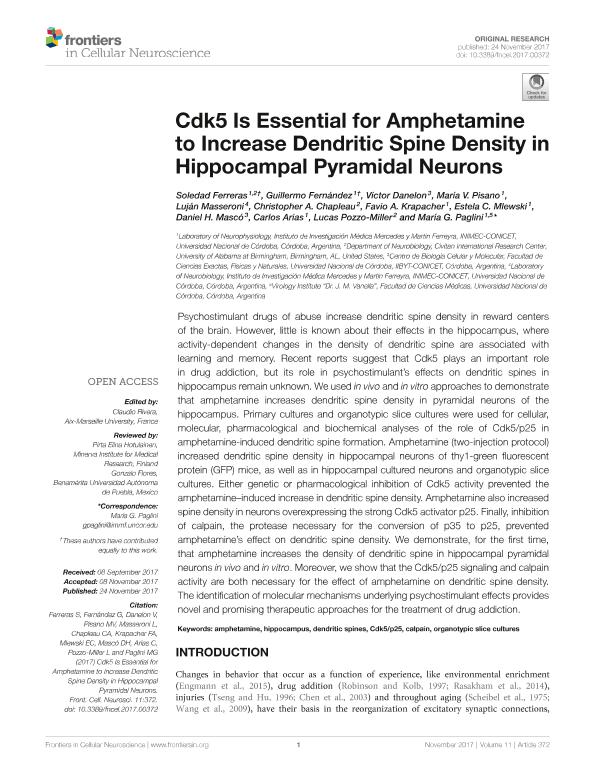Artículo
Cdk5 is essential for amphetamine to increase dendritic spine density in hippocampal pyramidal neurons
Ferreras, Soledad ; Fernández, Guillermo César
; Fernández, Guillermo César ; Danelon, Víctor
; Danelon, Víctor ; Pisano, María Victoria
; Pisano, María Victoria ; Masseroni, Maria Luján
; Masseroni, Maria Luján ; Chapleau, Christopher; Krapacher, Favio Ariel
; Chapleau, Christopher; Krapacher, Favio Ariel ; Mlewski, Estela Cecilia
; Mlewski, Estela Cecilia ; Masco, Daniel Hugo
; Masco, Daniel Hugo ; Arias Grandio, Carlos
; Arias Grandio, Carlos ; Pozzo Miller, Lucas; Paglini, Maria Gabriela
; Pozzo Miller, Lucas; Paglini, Maria Gabriela
 ; Fernández, Guillermo César
; Fernández, Guillermo César ; Danelon, Víctor
; Danelon, Víctor ; Pisano, María Victoria
; Pisano, María Victoria ; Masseroni, Maria Luján
; Masseroni, Maria Luján ; Chapleau, Christopher; Krapacher, Favio Ariel
; Chapleau, Christopher; Krapacher, Favio Ariel ; Mlewski, Estela Cecilia
; Mlewski, Estela Cecilia ; Masco, Daniel Hugo
; Masco, Daniel Hugo ; Arias Grandio, Carlos
; Arias Grandio, Carlos ; Pozzo Miller, Lucas; Paglini, Maria Gabriela
; Pozzo Miller, Lucas; Paglini, Maria Gabriela
Fecha de publicación:
11/2017
Editorial:
Frontiers Research Foundation
Revista:
Frontiers in Cellular Neuroscience
ISSN:
1662-5102
Idioma:
Inglés
Tipo de recurso:
Artículo publicado
Clasificación temática:
Resumen
Psychostimulant drugs of abuse increase dendritic spine density in reward centers of the brain. However, little is known about their effects in the hippocampus, where activity-dependent changes in the density of dendritic spine are associated with learning and memory. Recent reports suggest that Cdk5 plays an important role in drug addiction, but its role in psychostimulant?s effects on dendritic spines in hippocampus remain unknown. We used in vivo and in vitro approaches to demonstrate that amphetamine increases dendritic spine density in pyramidal neurons of the hippocampus. Primary cultures and organotypic slice cultures were used for cellular, molecular, pharmacological and biochemical analyses of the role of Cdk5/p25 in amphetamine-induced dendritic spine formation. Amphetamine (two-injection protocol) increased dendritic spine density in hippocampal neurons of thy1-green fluorescent protein (GFP) mice, as well as in hippocampal cultured neurons and organotypic slice cultures. Either genetic or pharmacological inhibition of Cdk5 activity prevented theamphetamine?induced increase in dendritic spine density. Amphetamine also increased spine density in neurons overexpressing the strong Cdk5 activator p25. Finally, inhibition of calpain, the protease necessary for the conversion of p35 to p25, prevented amphetamine?s effect on dendritic spine density. We demonstrate, for the first time, that amphetamine increases the density of dendritic spine in hippocampal pyramidal neurons in vivo and in vitro. Moreover, we show that the Cdk5/p25 signaling and calpain activity are both necessary for the effect of amphetamine on dendritic spine density. The identification of molecular mechanisms underlying psychostimulant effects provides novel and promising therapeutic approaches for the treatment of drug addiction.
Archivos asociados
Licencia
Identificadores
Colecciones
Articulos(CCT - CORDOBA)
Articulos de CTRO.CIENTIFICO TECNOL.CONICET - CORDOBA
Articulos de CTRO.CIENTIFICO TECNOL.CONICET - CORDOBA
Articulos(CICTERRA)
Articulos de CENTRO DE INVEST.EN CS.DE LA TIERRA
Articulos de CENTRO DE INVEST.EN CS.DE LA TIERRA
Articulos(INIMEC - CONICET)
Articulos de INSTITUTO DE INV. MEDICAS MERCEDES Y MARTIN FERREYRA
Articulos de INSTITUTO DE INV. MEDICAS MERCEDES Y MARTIN FERREYRA
Citación
Ferreras, Soledad; Fernández, Guillermo César; Danelon, Víctor; Pisano, María Victoria; Masseroni, Maria Luján; et al.; Cdk5 is essential for amphetamine to increase dendritic spine density in hippocampal pyramidal neurons; Frontiers Research Foundation; Frontiers in Cellular Neuroscience; 11; 372; 11-2017; 1-14
Compartir
Altmétricas



